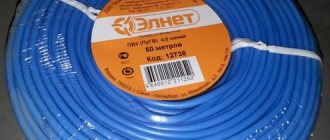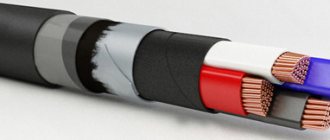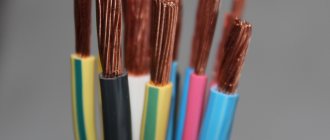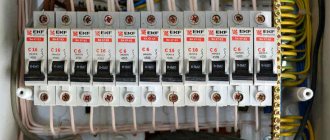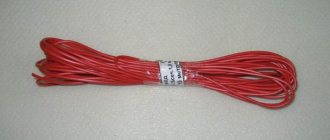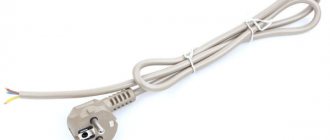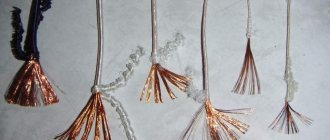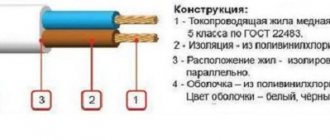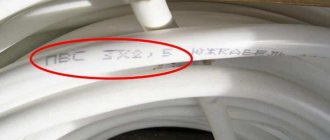A flexible conductor is required for the electrical connection of equipment operating under shaking and vibration conditions. The installation wire PuGV has gained particular popularity. A successful design ensures reliable installation of machine tools, electrical machines and mechanisms. The availability of the material makes it possible to lay stationary networks in industrial premises and housing with a rated alternating current voltage of up to 450V.
The material in this article will help you get acquainted with this wonderful product, characteristics, and applications.
Description and design of the PuGV wire
Installation wire PuGV is a wire with one flexible copper core, with PVC insulation, without a sheath.
Explanation of the designation:
absence of the letter “A” at the beginning – copper core; “Pu” - installation wire; “G” - for installation conditions requiring increased flexibility; “B” - PVC insulation, including low fire hazard and heat-resistant;
Designation example: PuGV-2.5 - PuGV wire with a conductor cross-section of 2.5 mm2
Since PuGV installation wires are intended mainly for industrial use and are designed for a long service life, GOST sets strict requirements for finished products in terms of structural, electrical and mechanical parameters. The values of individual parameters are also regulated for the period of operation and storage.
The range of produced cross-sections of PuGV installation wires is from 0.5 to 95 mm2.
The cores must be twisted from individual wires (at least 7 wires for sections up to 1.5 mm2 inclusive and with the diameter of individual wires for the most used sections not exceeding that indicated in the table).
| Section | Diameter of individual wire, mm |
| 2,5 | 0,43 |
| 4 | 0,53 |
| 6 | 0,65 |
| 10 | 0,82 |
| 16 | 0,65 |
| 25 | 0,82 |
| 35 and 50 | 0,69 |
The insulation must fit tightly to the core and be removed without damaging the core. The nominal and minimum values of the radial insulation thickness and the maximum outer diameter for wires of the most commonly used sections up to 50 mm2 are given in the table.
| Nominal cross-section, mm 2 | Nominal insulation thickness, mm | Minimum insulation thickness, mm | Maximum outer diameter, mm |
| 0,75 | 0,6 | 0,44 | 2,6 |
| 1,0 | 0,7 | 0,53 | 2,8 |
| 1,5 | 0,7 | 0,53 | 3,1 |
| 2,5 | 0,8 | 0,62 | 3,9 |
| 4 | 0,8 | 0,62 | 4,4 |
| 6 | 0,8 | 0,62 | 4,9 |
| 10 | 1,0 | 0,8 | 6,4 |
| 16 | 1,0 | 0,8 | 8,0 |
| 25 | 1,2 | 0,98 | 9,8 |
| 35 | 1,2 | 0,98 | 11,0 |
| 50 | 1,4 | 1,16 | 13,0 |
It is allowed to repeat the configuration of the current-carrying core on the insulation surface within permissible deviations.
PuGV wires must be made in various colors. The coloring must be solid or done by applying two longitudinal stripes to the insulation of a natural color, located diametrically. For single-core wires used for grounding purposes, the insulation should be a solid yellow-green color.
The color of solid insulation or longitudinal strips must be specified in the order (the letters indicated in the table are added to the wire designation when ordering, for example: PuGV-2.5 Zh).
| Designation | Color |
| White, natural or gray | B |
| Yellow or orange or purple | AND |
| Red or pink | TO |
| Blue or cyan | WITH |
| Green | Z |
| Brown | Kch |
| Black | H |
| Yellow-green | Z-Z |
If there is no indication of a specific color in the order, the manufacturer supplies wires at its discretion, while it is allowed to supply wires with insulation of transitional and mixed colors (designation “BC”) in a volume of no more than 10% of the batch.
Application area
The wire described is a type of multifunctional material. The wide range of cross-sectional areas (0.5-240 mm²) and high flexibility with low resistivity make it applicable in many areas of electronics and mechanical engineering.
Terminal box
Interesting. Cars, motorcycles, scooters and other vehicles when organizing electrical wiring give preference to PuGV wires.
Technical characteristics of PuGV wire
The electrical resistance of current-carrying conductors at direct current for wires with a cross-section of up to 50 mm2 upon acceptance and delivery must be no more than that indicated in the table. For wires with a cross section of 0.75; 1 and 1.5 mm 2 core resistance depends on the core design.
| Nominal conductor cross-section, mm2 | 0,75 | 1,0 | 1,5 | 2,5 | 4 | 6 | 10 | 16 | 25 | 35 | 50 |
| Copper conductor resistance, Ohm/km | 24,5-25,5 | 18,1-21,8 | 12,1-14,0 | 7,41 | 4,61 | 3,11 | 1,99 | 1,21 | 0,809 | 0,551 | 0,394 |
For the period of operation and storage, it is allowed to increase the specified resistance values of the cores by 20%.
The electrical insulation resistance per 1 km of length at a temperature of 20°C must be at least 1 MOhm upon acceptance and delivery and at least 0.01 MOhm for the period of operation and storage.
Upon acceptance and delivery, finished wires must withstand, when immersed in water without preliminary exposure to it, testing with an alternating voltage of 2000 V at a frequency of 50 Hz for 5 minutes, applied between the conductor and water (for the period of operation and storage - 1000 V under the same conditions).
The wires must withstand winding at a temperature of minus 15°C into a cylinder (drum) with a diameter equal to 5 outer diameters of the wire (on a special installation directly in the refrigerating chamber).
Purpose
In cases where space is limited, but it is necessary to make high-quality installation of electrical equipment, flexible PuGV is used, and also if power wires energized up to 450 V are supposed to be bent frequently. For example, objects that have vibration or some movement are connected, wires collected in bundles and tied with a thread (they can be bent during operation). They can be placed in sleeves, attached to a cable and moved along it.
PuGV is used in enclosed spaces to connect various devices and units. It is allowed to be installed in walls under plaster. External use is allowed, but under a canopy, with mandatory protection from ultraviolet rays. Do not expose the wire to moisture from precipitation. Since stranded wire has a large surface area, contact with moisture results in rapid oxidation. Solid rod is less susceptible to corrosion. To prevent this drawback, tinned wires are used.
Wire flexibility category
This is interesting: Methods for attaching wires and cables to the wall
Labeling requirements
Wires must have the manufacturer's designation and the wire identification, which must be made in the form of a continuous marking on the insulation surface. The marking may be printed, embossed or stamped onto the surface of the wire. The distance from the end of the marking to the beginning of the next one should not exceed 500 mm. It is allowed to mark wires with a cross-section of up to 6 mm2 in the form of a distinctive thread or colored stripes or solid marks.
The label attached to the coil or drum, or on the cheek of the drum, must indicate:
— trademark of the manufacturer; — symbol of the wire (full, indicating the number of cores and cross-section); — length in meters; — gross weight (for drums) in kilograms — date of manufacture (year, month); — GOST designation.
The label must bear a technical control stamp and a certification mark.
For wires supplied on a drum, the label attached to the coil or drum, or on the cheek of the drum, must indicate the number of sections and their length through a plus sign from the top to the bottom layers in meters.
Difference from PV-3
PV-3
Wires PV-3, PV-4 and PUGV are analogues. To understand whether there are differences in them, you need to understand their parameters.
PV-3 is a power element used at the declared operating voltage and direct current. Used in cases where increased flexibility of the product is important. It has insulation that is not subject to fire and mold. Withstands temperatures up to 150° C.
The PUGV conductor has minimal differences that allow them to replace PV-3 and PV-4. The main difference is the number of cores. PUGV has 5 cores, which make the cable more flexible. There are also minimal changes in insulation temperature limits and ambient humidity. All changes that have occurred with the cable are associated with changes in GOST, therefore PV-3 and PA-4 are complete analogues.
Weight and size parameters of PuGV wire
Approximate weights of the most common wire cross-sections for packaging and transportation purposes are given in the table. The given values may differ for wires of different batches and manufacturers by 10% less or more.
| Section | Weight value for packaging and transportation purposes, kg/km |
| 0,75 | 12 |
| 1,0 | 14 |
| 1,5 | 20 |
| 2,5 | 31 |
| 4 | 48 |
| 6 | 70 |
| 10 | 116 |
| 16 | 182 |
| 25 | 287 |
| 35 | 378 |
| 50 | 520 |
Main manufacturers
When purchasing cable and wire products, it is important to obtain specified parameters that can ensure the nominal operating conditions of the system. Otherwise, you may encounter the problem of insufficient cross-section or inappropriate climatic design, when the connected wire or cable begins to overheat and lead to a line burnout. Therefore, it is so important to purchase PV3 only from trusted manufacturers. Among the well-established factories, the following should be highlighted:
- TD Alliance Cable;
- Special cable;
- Moskabelmet;
- Interregional trade and industrial company.
If you are just going to buy PV3 wire, pay attention to the products of the above-mentioned factories. If you already have a brand of PV3 wire from some other manufacturer, and you want to use it in electrical work, it is better to check its cross-section and the quality of the insulation.
PuGV wire load currents
Permissible load currents for wires are not regulated in GOST. In accordance with the PUE, for any installation method it is recommended that for single wires not exceed the load currents indicated in the table.
| Nominal conductor cross-section, mm2 | Permissible load current, A |
| 0,75 | 15 |
| 1,0 | 17 |
| 1,5 | 23 |
| 2,5 | 30 |
| 4 | 41 |
| 6 | 50 |
| 10 | 80 |
| 16 | 100 |
| 25 | 140 |
| 35 | 170 |
| 50 | 215 |
Check upon purchase
It is recommended to check the PV-3 cable very carefully before purchasing, since the market is flooded with a large number of fakes, characterized at best by an undersized cross-section, and at worst by a complete non-compliance with the stated requirements, primarily in terms of safety.
- It is always recommended to take products that are labeled with the wording GOST, and not TU. A cable made according to specifications is not formally considered a fake, but the fact is that each manufacturer determines the “technical conditions” for himself.
- A label should always be stuck on the bay, and alphanumeric markings should be applied to the insulation in a certain increment (about half a meter).
- Check the cross-section with a caliper you take with you.
- Request from the seller documents that the wire has passed the conductor resistance test, the insulation breakdown test, and the voltage test.
In addition, periodically during operation the cable must undergo “running tests”.
Available methods for quality control of PuGV wire
Control methods are presented that, while not strictly complying with GOST, allow preliminary conclusions to be drawn about the quality of the wire if the measured values differ significantly from the regulated ones. The final conclusion about the compliance of the wire with GOST can be made only after testing the wire in a specialized laboratory using strict methods and in the volumes specified in GOST.
Visual inspection. The following can be checked: marking, number of wires in the core, color and integrity of the insulation.
Measuring structural dimensions. The insulation thickness and outer diameter can be checked using suitable measuring instruments. Measuring the wire diameter dpr and calculating the cross-section of the core using the formula 0.785dpr2N (where N is the number of wires in the core) is not a strict method for controlling the cross-section of the cores, because confirmation of cross-section compliance is electrical resistance, however, a significant deviation of the calculated cross-section from the nominal (more than 10%) may serve as a basis for doubts about the quality.
Measuring the electrical resistance of current-carrying conductors. It can be carried out on the finished wire with an ohmmeter with a suitable measurement limit (with a small cross-section and the normal length of the wire in a coil or on a drum can be several Ohms) and recalculated to a length of 1 km. Particular attention should be paid to making good contact with the test leads.
Analogues, manufacturers and selection of suitable cable
Analogue PV-3
The installation wire PUGV is a complete analogue of the classic electrical installation product PV. It can completely replace devices such as PV-3 and PV-4.
Almost all Russian manufacturers offer high quality wires. But at the same time, we can highlight the leading domestic manufacturers of electrical installation products, which include:
- Energy cable;
- Kavkazcable;
- Kamkabel.
When choosing a wire from any manufacturer, you should use the following recommendations:
- Visual inspection of the wire. It is necessary to ensure the integrity of the structure and the compliance of the declared cross-section with reality.
- Determination of core resistance. Can be done using an ohmmeter.
- Carrying out electrical insulation tests. To do this, its resistance is measured and high-voltage tests are carried out.
- Checking the labeling for correctness. Using a conductor without proper markings can be dangerous.
